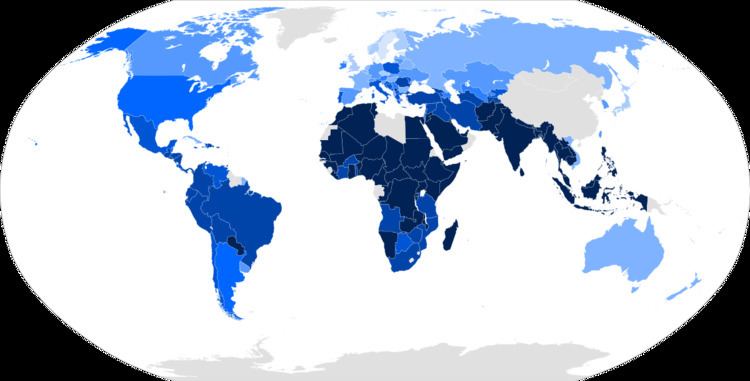 | ||
Religiosity, in its broadest sense, is a comprehensive term used to refer to the numerous aspects of religious activity, dedication, and belief (religious doctrine). Another term less often used is "religiousness". In its narrowest sense, religiosity deals more with how religious a person is, and less with how a person is religious (in practicing certain rituals, retelling certain stories, revering certain symbols, or accepting certain doctrines about deities and afterlife).
Contents
Diversity in an individuals' beliefs, affiliations, and behaviors
Decades of anthropological, sociological, and psychological research have established that "religious congruence" (the assumption that religious beliefs and values are tightly integrated in an individual's mind or that religious practices and behaviors follow directly from religious beliefs or that religious beliefs are chronologically linear and stable across different contexts) is actually rare. People’s religious ideas, are fragmented, loosely connected, and context dependent; like in all other domains of culture and in life. The beliefs, affiliations, and behaviors of any individual are complex activities that have many sources including culture. As examples of religious incongruence he notes, "Observant Jews may not believe what they say in their Sabbath prayers. Christian ministers may not believe in God. And people who regularly dance for rain don’t do it in the dry season."
Demographical Data
Demographic studies often show wide diversity of religious beliefs, belonging, and practices in both religious and non-religious populations. For instance, out of Americans who are not religious and not seeking religion: 68% believe in God, 12% are atheists, 17% are agnostics; also, in terms of self-identification of religiosity 18% consider themselves religious, 37% consider themselves as spiritual but not religious, and 42% considers themselves as neither spiritual nor religious; and 21% pray every day and 24% pray once a month. Global studies on religion also show diversity.
Components
Numerous studies have explored the different components of human religiosity (Brink, 1993; Hill & Hood 1999). What most have found is that there are multiple dimensions (they often employ factor analysis). For instance, Cornwall, Albrecht, Cunningham and Pitcher (1986) identify six dimensions of religiosity based on the understanding that there are at least three components to religious behavior: knowing (cognition in the mind), feeling (affect to the spirit), and doing (behavior of the body). For each of these components of religiosity there were two cross classifications resulting in the six dimensions:
Other researchers have found different dimensions, ranging generally from four to twelve components. What most measures of religiosity find is that there is at least some distinction between religious doctrine, religious practice, and spirituality.
For example, one can accept the truthfulness of the Bible (belief dimension), but never attend a church or even belong to an organized religion (practice dimension). Another example is an individual who does not hold orthodox Christian doctrines (belief dimension), but does attend a charismatic worship service (practice dimension) in order to develop his/her sense of oneness with the divine (spirituality dimension).
An individual could disavow all doctrines associated with organized religions (belief dimension), not affiliate with an organized religion or attend religious services (practice dimension), and at the same time be strongly committed to a higher power and feel that the connection with that higher power is ultimately relevant (spirituality dimension). These are explanatory examples of the broadest dimensions of religiosity and that they may not be reflected in specific religiosity measures.
Most dimensions of religiosity are correlated, meaning people who often attend church services (practice dimension) are also likely to score highly on the belief and spirituality dimensions. But individuals do not have to score high on all dimensions or low on all dimensions; their scores can vary by dimension.
Sociologists have differed over the exact number of components of religiosity. Charles Glock's five-dimensional approach (Glock, 1972: 39) was among the first of its kind in the field of sociology of religion. Other sociologists adapted Glock's list to include additional components (see for example, a six component measure by Mervin F. Verbit).
Genes and environment
The contributions of genes and environment to religiosity have been quantified in studies of twins (Bouchard et al., 1999; Kirk et al., 1999) and sociological studies of welfare, availability, and legal regulations (state religions, etc.).
Koenig et al. (2005) report that the contribution of genes to variation in religiosity (called heritability) increases from 12% to 44% and the contribution of shared (family) effects decreases from 56% to 18% between adolescence and adulthood.
A market-based theory of religious choice and governmental regulation of religion have been the dominant theories used to explain variations of religiosity between societies. However, Gill and Lundsgaarde (2004) documented a much stronger correlation between welfare state spending and religiosity. See "Welfare spending vs Church attendance" diagram on the right.
Intelligence levels
A meta-analysis found a correlation of -.24 between intelligence quotient (IQ) and religiosity for western societies. The correlation was suggested to be a result of nonconformity, more cognitive and less intuitive thinking styles among the less religious, and less of a need for religion as a coping mechanism. The study noted limitations on the results such as not considering of the role of religion type and of culture in assessing the relationship.
Just-world hypothesis
Studies have found belief in a just world to be correlated with aspects of religiousness.
Risk-aversion
Several studies have discovered a positive correlation between the degree of religiousness and Risk aversion
